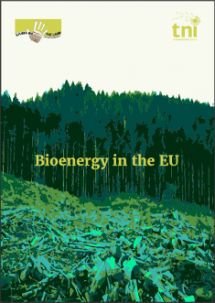Ideas into movement
Boost TNI's work
50 years. Hundreds of social struggles. Countless ideas turned into movement.
Support us as we celebrate our 50th anniversary in 2024.

The European Union’s approach to bioenergy is shaped by contradictory policies. Climate concerns are highlighted in public discourse and assure broad public support for renewable energy, including bioenergy. Meanwhile, however, the EU’s corporate growth and trade agenda promotes the use of energy that actually increases the EU’s footprint on land elsewhere, with significant implications for environmental and social justice.

Renewable energy, generally speaking, enjoys broad public support within the EU. This support, however, should be understood in the context of a government-led public dialogue about renewable energy in Europe which has portrayed solar panels and wind turbines, rather than bioenergy, as the main sources of renewable energy in Europe, supplemented by bioenergy from agricultural and forestry residues, wood from forest thinnings and waste from e.g. sawmills or paper production. The role of bioenergy, and therefore its potential impacts, has been dramatically under-addressed in public discussion. The portrayal of wind and solar power as the central drivers of renewable energy in Europe has contributed to the broad public support renewable energy on the whole currently enjoys. However, this image does not reflect the reality of ‘renewable’ energy generation in the EU today.
Within this context, bioenergy was presented to EU citizens as better for the climate than energy produced from burning fossil fuel. It was said to be ‘carbon neutral’, because, while trees and agricultural crops release carbon when they are burned, they also absorb carbon while they are growing (as opposed to fossil fuels, which release carbon that was removed from the atmosphere centuries or millennia ago). It was also said to make an important contribution to increased energy self-sufficiency through reduced dependency on imported fuels. In addition it was highlighted that increased use of agricultural residues, energy crops, and wood from forests and tree plantations would provide an additional source of income to primary producers in rural areas. With these expectations and assumptions, combined with the ready availability of technology easily converted for large-scale biomass burning (e.g. in existing coal-fired power plants) it is perhaps no surprise that bioenergy came to play a much bigger role in the actual implementation of EU climate and energy policies than in public perception.
In 1995 ‘renewable energy’ (e.g.. bioenergy, wind, solar, etc.) made up 5% of total energy consumption in the EU. In 2013, this proportion had increased to approximately 12%, of which 7.7% came from biomass and renewable waste; 1.9% from hydro; 1.2% from wind; 0.6% from solar; 0.4% from geothermal; and 0.0% from tide, wave and ocean. Thus, almost two thirds of the ‘renewable energy’ consisted of bioenergy in 2013.
Residues from agriculture and forestry, manure and organic waste from households and industry are often highlighted by bioenergy advocates but in reality they make up a and decreasing portion of bioenergy source material. In spite of this, EU bioenergy policy continues to rest on the assumption that most biomass for future energy production will be sourced from within the EU and be made up of waste, residues and wood from thinnings. In fact, and contrary to policy goals of reducing reliance on energy imports and strengthening rural development, an increasing proportion of bioenergy consumed in the EU is produced from imported biomass.
Imported biomass is usually extracted at a large scale and often from biodiversity-rich forests or from areas subject to land rights disputes. It has become evident that bioenergy, when produced on such large scale, does not contribute to reducing greenhouse gas emissions. On the contrary, burning biomass at a large scale has been shown to often cause more emissions than burning fossil fuels.6 Yet, despite the mounting evidence of false assumptions and unmet expectations, the European Commission and EU Member State governments continue to ignore the major conflicts between EU policies promoting bioenergy and the goals proposed in EU policies and international agreements on sustainability, biodiversity, climate and food security. Instead of taking into account the experience of the past ten years of bioenergy promotion, which has led to large-scale devastation, the EU continues to subsidise bioenergy production that falls short on nearly all the aspirations on which its bioenergy policy was based in the first place.
Public support played a key role in establishing common policies for increased use of renewable energy. Public education is therefore indispensable in efforts to stop misguided policies that lead to exploitation of land and peoples’ livelihoods in the global South as well as destruction of forests rich in biological diversity in key biomass-exporting countries such as Canada, Russia and the USA.